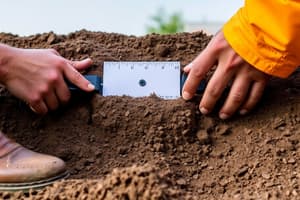Podcast
Questions and Answers
What are the primary purposes of soil testing before construction? (Select all that apply)
What are the primary purposes of soil testing before construction? (Select all that apply)
- To determine the chemical and physical composition of the soil (correct)
- To check the aesthetics of the soil
- To test the bearing capacity (correct)
- To ensure structure stabilization (correct)
What is the importance of soil in construction materials?
What is the importance of soil in construction materials?
It determines the quality and stability of the structure being built.
Soil classification is part of the testing processes mentioned.
Soil classification is part of the testing processes mentioned.
True (A)
Which of the following tests is NOT mentioned as a soil test?
Which of the following tests is NOT mentioned as a soil test?
A sample in testing means a small part or quantity intended to show what the whole is like. A sample is merely a small fraction of the _____ material.
A sample in testing means a small part or quantity intended to show what the whole is like. A sample is merely a small fraction of the _____ material.
What is materials testing?
What is materials testing?
Match the following pavement composition items with their descriptions:
Match the following pavement composition items with their descriptions:
Flashcards are hidden until you start studying
Study Notes
Importance of Soil Testing
- Soil testing assesses bearing capacity, essential for stable foundations in construction.
- Examines the chemical and physical properties of soil for proper material selection.
- Critical for predicting soil behavior under loads, especially for roadways.
- Ensures structural stability and safety of construction projects.
Types of Soil Tests
- Moisture Content Determination: Measures the water content in soil.
- Sieve Analysis (Grading Test): Analyzes particle size distribution.
- Plastic and Liquid Limit Tests: Determines the plasticity characteristics of soil.
- Soil Classification (AASHTO): Categorizes soil types based on specific criteria.
- Compaction Test: Establishes moisture-density relationships for optimal compaction.
- Field Density Test: Measures the in-situ density of soil.
- California Bearing Ratio (CBR) Test: Assesses the strength of soil for subgrade and base courses.
- Abrasion Test: Evaluates material resistance to wear and tear.
Objectives of Soil Testing
- Understand the significance of soil properties in construction materials.
- Identify and perform various soil tests.
- Interpret results from soil tests and understand their implications.
- Ensure samples are representative of the overall material quality.
Sampling Techniques
- Soil Sampling: Critical for obtaining materials to test.
- Methods:
- Mechanical Splitter: Efficiently divides samples.
- Quartering Method: Reduces samples to manageable sizes.
Materials Testing Overview
- Essential for determining material quality before use.
- Ensures quality assurance through controlled testing methods at the source.
- Testing measures help maintain quality standards in construction projects.
Minimum Requirements for Sample Submission
- Soil Aggregates Testing:
- 1 sample per 1500 cu.m. of soil aggregates.
- Minimum Material Amounts:
- Classification tests require 20 kg.
- Routine tests require 50 kg.
- Moisture Density Relation & CBR tests require 50 kg.
Soil Properties for Construction
- Stability: Ensures the soil can bear loads without excessive deformation.
- Incompressibility: Prevents volume changes under load.
- Permanency of Strength: Maintains strength over time.
Pavement Composition
- Comprises several layers:
- Embankment: Distributes loads to the subgrade; used to elevate roadway grades.
- Subgrade: Provides foundational support for overlying layers, prepared to specified widths.
- Subbase and Base: Built from durable materials to enhance structural integrity.
Construction and Quality Control
- Spreading and Compacting: Essential process in creating a stable foundation, particularly where thickness is 150 mm or less.
- Aggregate subbase materials must be hard, durable, and free from organic matter for effective performance.
Studying That Suits You
Use AI to generate personalized quizzes and flashcards to suit your learning preferences.




